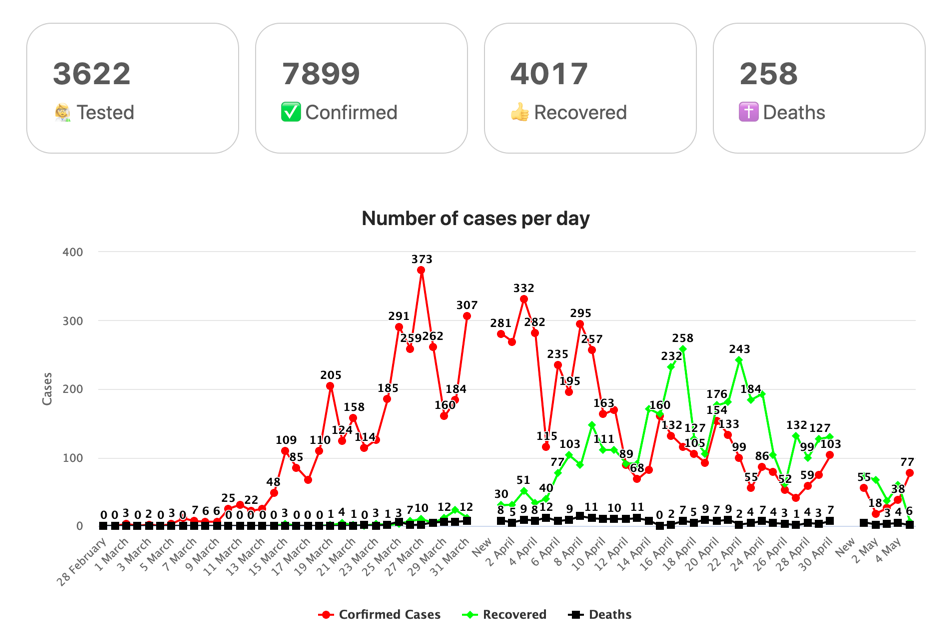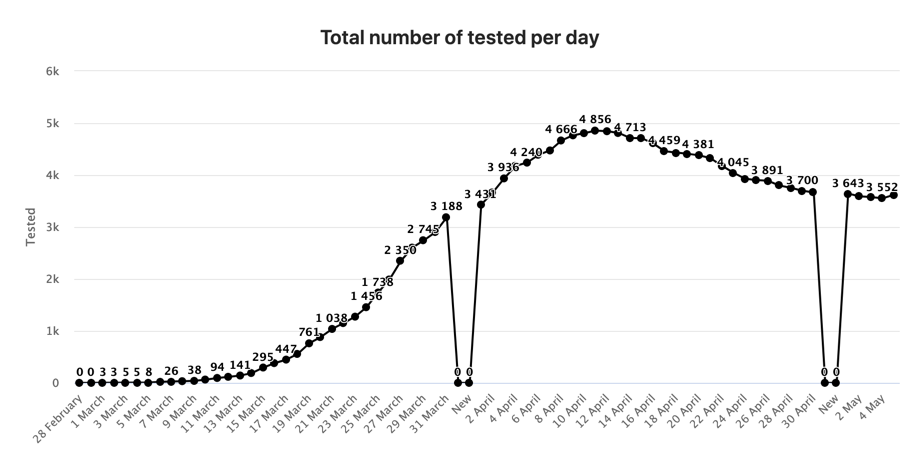Handicapping economic outcomes after the third phase of recession
We are now entering the insolvency phase of this recession, where, despite government’s best efforts, the weakest companies go under and unemployment rises. This shakeout will take months. But the economy will rebound out of recession well before the bloodletting is over. And hopefully, we will grind upward toward a stable future. That’s my best case outlook.
But can we put more meat on the bones here? Can we handicap outcomes during and after this insolvency phase? I think we can and want to start that process in this post. But to go about this exercise, I must (unfortunately) touch on my third rail of this economic crisis, epidemiology. I simply can’t assess likely outcomes without making some baseline assumptions about the health crisis that is at the center of the economic crisis. So I want to start there and work outwards.
The Swedish example
I have heard a lot of chatter about Swedish state epidemiologist Anders Tegnell in the press because of Sweden’s unique approach to the coronavirus pandemic. And I can understand this because I was early in predicting the lockdown and quarantine approach that has been universally adopted throughout the world, simply because government leaders must show they believe every life matters in action as well as word.
Those that have condemned the Swedish light-touch approach feared this approach would be unable to control viral transmission. But, Swedish government data suggest we were wrong on that front. But it’s more than that. Many are also in disbelief that an industrialized country could avoid a strict lockdown and quarantine approach, still be considered humane, and have the backing of the electorate. But, so far, Sweden’s approach has not put off its citizens despite deaths attributed to Covid-19 that are 4,5, and 6 times higher as a percentage of the population than elsewhere in Scandinavia.
At the same time, for a number of weeks now, I have been predicting that the economic consequences of the strict lockdown approach would be so devastating and all-consuming, it would force an abandonment of lockdowns. And in some cases, like the US, the abandonment would happen before R0s, the disease transmission rates, declined below 1. That prediction also seems to be panning out both on the economic front and on the policy action side as well.
It’s not clear what the eventual outcome will be in terms of health or economic outcomes for Sweden or for those countries that went harder into lockdown and re-emerged afterwards. But I don’t know if you can make apples to apples comparisons on this front. Sweden has a lower population density than many countries, it was not hit hard by the virus at the outset, and it was well-prepared in terms of a pandemic response team. All of those things have allowed Sweden to take its light-touch approach and still ‘flatten the curve’. It’s not clear how many other European countries could have done the same.
Herd Immunity
Some believe Sweden is driving toward herd immunity via mass infection. I don’t see any evidence they are. My understanding is that the Swedes are simply trying to maintain the most normal medium-to-long term sustainable living conditions until the lethality of coronavirus is no longer an imminent threat. That can certainly happen via uncontrolled viral spread. But, achieving that outcome in an uncontrolled way will overwhelm healthcare systems.
The Swedish approach is designed to prevent the healthcare system from becoming overwhelmed while avoiding drastic lifestyle changes. Have they struck the right balance? I don’t know. But an interesting article by former Swedish state epidemiologist Johan Giesecke in Svenska Dagbladet today gives me more faith in that approach.
The link to the article in Swedish is here. And Google Translate does an excellent job of translating to English. But let me outline the most important points he makes.
- Calculations based on PCR testing indicate that over 500,000 people in the Stockholm region have already had a Covid-19 infection. That’s 20-25 percent of the population.
- Almost all of these people are unaware of their infection or uncertain that they have had the infection because they were asymptomatic or their symptoms were mild.
- An increase from 0 to half a million people infected in just over two months in Sweden shows how quickly this disease spreads.
- Conclusion: eventually everyone on earth will be exposed to the Covid-19 virus, and most will be infected.
- Thus, his hypothesis is that measures to flatten the curve will meaningfully slow transmission, but a shutdown only pushes serious cases into the future. It does not cure them or make them go away. Only infection or a vaccine can do that.
- Thus, slowing the spread is mostly about preventing healthcare system overload until herd immunity is reached either through infection or vaccine.
- And here is the kicker: he says that “in general, for most diseases, you almost always get a more complete immune response from a “natural” illness than from a vaccine, and if the protection you get from a Covid-19 infection is weak or short-lived, there is a risk that vaccines will not be especially protective.”
Wow. That’s sobering stuff.
Look, I am not a scientist. So I can’t judge from a position of authority how correct his line of reasoning is. But, the implications are clear.
- The coronavirus will be with us for a long time, infecting people and causing death.
- To the degree there is a trade-off between slowing viral transmission and keeping the economy moving, collectively our lockdown and quarantine approach to date has simply served to buy time to better prepare us for the longer-term.
- Moving forward, having seen the economic damage, a return to the full lockdown approach is only advisable if a country’s preparedness falls so short that R0s rise to the point that infections would likely overwhelm the healthcare system.
Outcomes
So what does this mean about what’s likely to happen next?
On the Covid-19 front, there are two lines of thought I am concerned with. First, is the level of ‘herd immunity’ and second is the level of preparedness. Let’s use the Czech Republic and the United States respectively as examples.
The Czech Republic was well-prepared for the pandemic. It saw its first three cases on 1 March. 11 days later, the government declared a state of emergency. On 16 March, it closed its borders and issued a countrywide curfew. It tested widely as well. As a result, overall, the infection rate and the number of death have been low.
Here are charts cobbled together from various sources. Also see Wikipedia.


The result is that the Czech Republic was able to start easing restrictions already on 7 April.
The problem is ‘herd immunity’. Mass testing began in April. And out of 26,549 people tested only 107 had antibodies (link here in Swedish). That’s about 0.4% of the population. If Johan Giesecke is right that the coronavirus will be with us for a very long time, you will need to see the Czech Republic continue to do mass testing and assiduously follow a quarantine and contact tracing protocol to isolate viral clusters. Otherwise, the transmission rates will explode. It’s very doable. But you have to be well-prepared.
The United States is the other example here. The latest antibody study shows that up to 20% of New York City residents have had the coronavirus. What that means is that, in densely populated New York, 1 in 5 have antibodies, which is a rate 50 times higher than in the Czech Republic.
This has come at a severe and lethal cost, especially in minority communities. The healthcare system was overwhelmed. The psychological scars will last a lifetime for many a New York City resident. What has happened in New York is exactly why governments put strict lockdowns in place. Luckily, the worst is over for this first wave in New York because of those measures.
But when you look at the United States as a whole, excepting the New York metropolitan area, the case and death count is still rising. The worst is likely still to come, even as lockdown protocols are relaxed amid an environment of unpreparedness on testing. To me, it looks as if it’s almost a worst case scenario for viral spread and healthcare system overload. Covid-19 data models have shifted dramatically as a result. They now show many more deaths are coming to the US in this first wave.
Which outcome is better – the Czech one or the American one?
My Take
I think the Czech outcome is the better one because, while they will go through a long struggle with an ever-present invisible enemy, the Czechs look well-prepared to defend themselves. And the US does not. That ensures better human outcomes and economic outcomes too as we know from studies of the 1918 flu epidemic.
Data came out today from Europe that shows us the scale of the economic carnage during the lockdown period. The Italian services PMI was at 10.8, ahead of expectations. The German one came in ahead of expectations too at 16.2. The French were below at 10.2. Overall, Europe was at 12.0 for services, ahead of 11.7 expected and at 13.6, also ahead of expectations.
I look at this as good news actually, because Europe is already beating lowered expectations. And since it is coming out of lockdown now, the numbers will rise from here. That will put a floor under risk assets there – despite the political and sovereign debt carnage caused by yesterday’s German Constitutional Court decision.
But, longer-term, the outlook is poor. The European Commission forecasts that the eurozone is heading for its worst GDP contraction on record at 7.75% this year. Greece will be down -9.7%. That’s worse than the sovereign debt crisis. Italy is at -9.5%, Spain -9.4%, France -8.2%. Even Germany will see its economy contract -6.5%. And despite the predicted rebound in 2021, we have a long road ahead economically and regarding combatting the virus.
In Sweden, official figures show the country’s economy shrinking by just 0.3% in the first three months of 2020. And that’s a great result considering the Riksbank had predicted a drop of between 0.8 and 1.8%. But the Swedish purchasing managers’ index fell to 36.7 in April from 42.6 in March. That’s a lot higher than the numbers for the eurozone. Even so, it is still well below 50, which means recession.
SEB’s Olle Holmgren says the economy could shrink at a 14% rate in the second quarter and nearly 7% for 2020 as a whole. So, the Swedes don’t get a get-out-of-jail-free card here.
If I had to handicap outcomes then, I am still in the depression with a small d camp as a base case. I see the virus hanging around for the long term, shifting consumer behavior and disrupting the economy for months and years to come. And that will mean an L- or W-shaped economic outcome as we only slowly regain our footing in the post-coronavirus world.
The pitfalls are many though. We saw that with the German quantitative easing court decision yesterday. We see that with the bankruptcies that are likely to come fast and furious now. For example, Norwegian Cruise Lines looks to be on the brink. And while they might get a bailout because of their size, the government can’t save every company from bankruptcy. We see the pitfalls with the anti-Chinese sentiment too. An internal Chinese report warns Beijing faces a Tiananmen-like global backlash over the virus.
So, we face a very uncertain economic future. And unfortunately, most of the longer-term risks are to the downside.
P.S. – My antibody test result came in as I wrote this post. I tested negative. I don’t know if that’s a good thing or a bad thing. In many ways, I am thinking it would have been better if the result was positive.
Comments are closed.